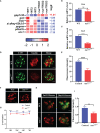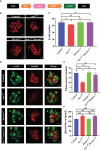Knockout of Nur77 Leads to Amino Acid, Lipid, and Glucose Metabolism Disorders in Zebrafish
- PMID: 35547009
- PMCID: PMC9084189
- DOI: 10.3389/fendo.2022.864631
Knockout of Nur77 Leads to Amino Acid, Lipid, and Glucose Metabolism Disorders in Zebrafish
Abstract
Orphan nuclear receptor Nur77 has been reported to be implicated in a diverse range of metabolic processes, including carbohydrate metabolism and lipid metabolism. However, the detailed mechanism of Nur77 in the regulation of metabolic pathway still needs to be further investigated. In this study, we created a global nur77 knockout zebrafish model by CRISPR/Cas9 technique, and then performed whole-organism RNA sequencing analysis in wildtype and nur77-deficient zebrafish to dissect the genetic changes in metabolic-related pathways. We found that many genes involved in amino acid, lipid, and carbohydrate metabolism changed by more than twofold. Furthermore, we revealed that nur77-/- mutant displayed increased total cholesterol (TC) and triglyceride (TG), alteration in total amino acids, as well as elevated glucose. We also demonstrated that the elevated glucose was not due to the change of glucose uptake but was likely caused by the disorder of glycolysis/gluconeogenesis and the impaired β-cell function, including downregulated insb expression, reduced β-cell mass, and suppressed insulin secretion. Importantly, we also verified that targeted expression of Nur77 in the β cells is sufficient to rescue the β-cell defects in global nur77-/- larvae zebrafish. These results provide new information about the global metabolic network that Nur77 signaling regulates, as well as the role of Nur77 in β-cell function.
Keywords: Nur77; glucose metabolism; lipid metabolism; transcriptomics; zebrafish; β cells.
Copyright © 2022 Xu, Tian, Kang, Yuan, Liu, Li, Liu and Li.
Conflict of interest statement
The authors declare that the research was conducted in the absence of any commercial or financial relationships that could be construed as a potential conflict of interest.
Figures







Similar articles
-
Insulin resistance and altered systemic glucose metabolism in mice lacking Nur77.Diabetes. 2009 Dec;58(12):2788-96. doi: 10.2337/db09-0763. Epub 2009 Sep 9. Diabetes. 2009. PMID: 19741162 Free PMC article.
-
Nur77 regulates lipolysis in skeletal muscle cells. Evidence for cross-talk between the beta-adrenergic and an orphan nuclear hormone receptor pathway.J Biol Chem. 2005 Apr 1;280(13):12573-84. doi: 10.1074/jbc.M409580200. Epub 2005 Jan 6. J Biol Chem. 2005. PMID: 15640143
-
Role of phosphoenolpyruvate carboxykinase 1 (pck1) in mediating nutrient metabolism in zebrafish.Funct Integr Genomics. 2023 Feb 25;23(1):67. doi: 10.1007/s10142-023-00993-6. Funct Integr Genomics. 2023. PMID: 36840800
-
Metabolism and insulin signaling in common metabolic disorders and inherited insulin resistance.Dan Med J. 2014 Jul;61(7):B4890. Dan Med J. 2014. PMID: 25123125 Review.
-
Nuclear receptor Nur77: its role in chronic inflammatory diseases.Essays Biochem. 2021 Dec 17;65(6):927-939. doi: 10.1042/EBC20210004. Essays Biochem. 2021. PMID: 34328179 Review.
Cited by
-
In Search of a Target Gene for a Desirable Phenotype in Aquaculture: Genome Editing of Cyprinidae and Salmonidae Species.Genes (Basel). 2024 Jun 1;15(6):726. doi: 10.3390/genes15060726. Genes (Basel). 2024. PMID: 38927661 Free PMC article. Review.
-
Therapeutic potential of NR4A1 in cancer: Focus on metabolism.Front Oncol. 2022 Aug 16;12:972984. doi: 10.3389/fonc.2022.972984. eCollection 2022. Front Oncol. 2022. PMID: 36052242 Free PMC article. Review.
-
Potential Role of NUR77 in the Aging Retinal Pigment Epithelium and Age-Related Macular Degeneration.Adv Exp Med Biol. 2025;1468:165-169. doi: 10.1007/978-3-031-76550-6_27. Adv Exp Med Biol. 2025. PMID: 39930190 Review.
-
Regulation of the Nur77-P2X7r Signaling Pathway by Nodakenin: A Potential Protective Function against Alcoholic Liver Disease.Molecules. 2024 Feb 29;29(5):1078. doi: 10.3390/molecules29051078. Molecules. 2024. PMID: 38474588 Free PMC article.
-
Novel Loss-of-Function Variant in HNF1a Induces β-Cell Dysfunction through Endoplasmic Reticulum Stress.Int J Mol Sci. 2022 Oct 27;23(21):13022. doi: 10.3390/ijms232113022. Int J Mol Sci. 2022. PMID: 36361808 Free PMC article.
References
MeSH terms
Substances
LinkOut - more resources
Full Text Sources
Molecular Biology Databases
Miscellaneous

